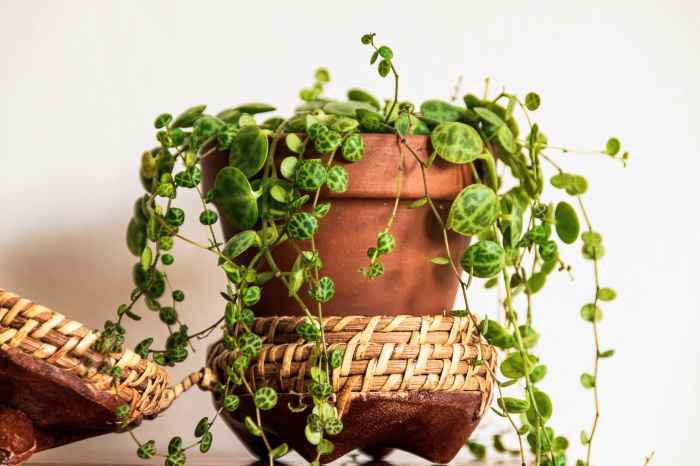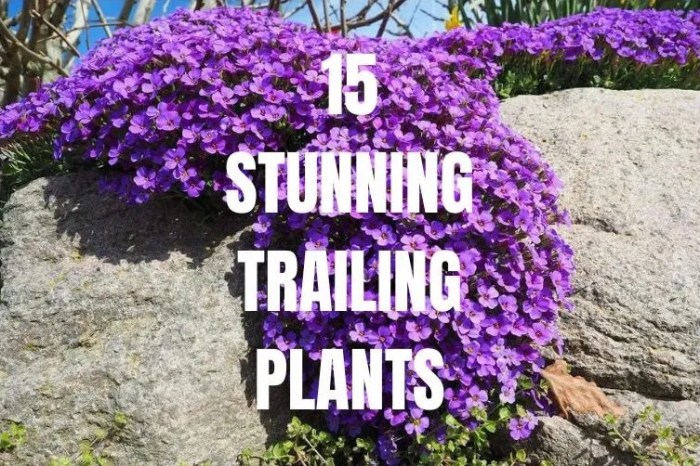Unleash the charm of small trailing plants as they gracefully cascade over hanging baskets, create lush vertical gardens, and transform ground covers into vibrant carpets. Embark on a journey into the world of these captivating plants, exploring their diverse varieties, care requirements, and decorative uses.
From the delicate tendrils of the String of Hearts to the cascading foliage of the Burro’s Tail, small trailing plants offer a myriad of textures, colors, and growth habits. Their adaptability makes them ideal for both indoor and outdoor environments, adding a touch of elegance to any space.
Plant Varieties

Small trailing plants are a diverse group of species that add beauty and charm to indoor and outdoor spaces. Their compact size and ability to cascade over edges or hang from containers make them ideal for a variety of decorative purposes.
Small trailing plants, known for their ability to cascade over edges, add a touch of elegance to any indoor space. To elevate their visual appeal, consider using indoor hanging baskets for plants . These baskets provide a unique way to display small trailing plants, allowing them to gracefully flow downwards, creating a lush and inviting atmosphere.
Whether you choose a macrame hanger or a classic wire basket, indoor hanging baskets offer a stylish and practical solution for showcasing your favorite small trailing plants.
These plants exhibit a wide range of leaf shapes, sizes, and colors, providing ample options to suit different tastes and preferences.
The following list showcases some popular small trailing plant species along with their unique characteristics:
Pothos (Epipremnum aureum), Small trailing plants
- Pothos is renowned for its heart-shaped leaves that come in various shades of green, yellow, and white.
- This easy-to-care-for plant thrives in low light conditions and is tolerant of occasional neglect.
Spider Plant (Chlorophytum comosum)
- Spider plants are characterized by their long, arching leaves that produce plantlets at the tips.
- They prefer bright indirect light and can tolerate low humidity.
String of Pearls (Senecio rowleyanus)
- String of Pearls features succulent, pea-shaped leaves that resemble a string of pearls.
- This plant requires well-draining soil and prefers bright indirect light.
Trailing Jade (Sedum morganianum)
- Trailing Jade is a succulent with plump, fleshy leaves that resemble jade stones.
- It thrives in bright indirect light and needs well-draining soil to prevent root rot.
Creeping Jenny (Lysimachia nummularia)
- Creeping Jenny is a low-growing groundcover with round, bright green leaves.
- This plant prefers moist soil and can tolerate full sun to partial shade.
Saxifraga (Saxifraga spp.)
- Saxifraga species offer a range of leaf shapes and textures, including rosettes, spikes, and serrated edges.
- They thrive in well-draining soil and prefer partial shade to full sun.
Ivy (Hedera spp.)
- Ivy is a classic trailing plant with lobed or variegated leaves.
- It is known for its ability to climb surfaces and can tolerate a wide range of light conditions.
Suitability for Different Environments
The suitability of small trailing plants depends on the specific environment and growing conditions:
- Indoor environments:Pothos, Spider Plant, String of Pearls, and Creeping Jenny are excellent choices for indoor spaces with low to moderate light levels.
- Outdoor environments:Trailing Jade, Saxifraga, and Ivy are suitable for outdoor gardens and containers, where they can thrive in various light conditions.
- Hanging baskets:All the mentioned plants are well-suited for hanging baskets, where their trailing stems can cascade gracefully.
- Groundcover:Creeping Jenny is an ideal choice for groundcover, providing a dense mat of foliage.
Care and Maintenance: Small Trailing Plants
Small trailing plants require specific care to thrive. Understanding their watering, fertilizing, pruning, and environmental needs is crucial for their well-being.
Watering
Trailing plants prefer evenly moist soil but not waterlogged conditions. Allow the top inch of soil to dry out before watering thoroughly. Avoid overwatering, as this can lead to root rot.
Fertilizing
Fertilize small trailing plants monthly during the growing season with a balanced liquid fertilizer. Follow the instructions on the fertilizer label for the appropriate dosage.
Pruning
Regular pruning encourages bushier growth and prevents the plants from becoming leggy. Pinch back the tips of the stems to stimulate branching and remove any dead or damaged leaves.
Lighting
Most small trailing plants prefer bright, indirect light. Avoid placing them in direct sunlight, as this can scorch the leaves.
Temperature
Trailing plants thrive in warm temperatures between 60-75°F (16-24°C). Avoid exposing them to extreme temperatures or cold drafts.
Humidity
Trailing plants prefer moderate to high humidity levels. Misting the leaves regularly or placing them on a pebble tray filled with water can help increase humidity.
Common Pests and Diseases
Trailing plants can be susceptible to pests such as mealybugs, aphids, and spider mites. Regularly inspect the plants for signs of infestation and treat promptly with an appropriate insecticide.
Decorative Uses

Small trailing plants offer immense decorative potential, transforming indoor and outdoor spaces with their cascading foliage and charming aesthetic. Their versatility extends to various applications, enhancing the ambiance and visual appeal of any setting.
These plants excel in hanging baskets, their cascading vines creating a lush and vibrant display. Vertical gardens benefit greatly from their ability to cover walls and trellises, adding a touch of greenery and texture to otherwise plain surfaces. As ground covers, they form a dense and eye-catching carpet, suppressing weeds and adding visual interest to garden beds and pathways.
Visual Impact and Ambiance
The decorative uses of small trailing plants extend beyond their aesthetic appeal. In indoor settings, they contribute to air purification, improving air quality and creating a healthier environment. Their presence brings a sense of tranquility and relaxation, fostering a calming and inviting atmosphere.
In outdoor spaces, they attract pollinators, creating a vibrant and lively ecosystem.
Small trailing plants, with their graceful cascades and verdant foliage, add a touch of elegance to any space. If you’re looking for the best trailing plants to elevate your home decor, explore our curated list of best trailing plants . From the delicate tendrils of ivy to the lush fronds of ferns, our selection offers a wide range of options to suit every style and space.
Whether you’re a seasoned plant enthusiast or just starting out, these small trailing plants will bring a touch of nature and tranquility to your home.
Propagation Techniques
Propagating small trailing plants allows gardeners to create new plants for their gardens or share them with others. There are several methods for propagating these plants, including stem cuttings, division, and layering.
Stem Cuttings
Stem cuttings are the most common method of propagating small trailing plants. This technique involves taking a cutting from a healthy stem and rooting it in a new pot or container. The best time to take stem cuttings is during the growing season, when the plants are actively growing.
To take a stem cutting, use a sharp knife or pruning shears to cut a 4- to 6-inch section from a healthy stem. Remove the leaves from the bottom 1 to 2 inches of the cutting. Dip the end of the cutting in rooting hormone, then plant it in a pot or container filled with well-draining potting mix.
Keep the potting mix moist and place the pot in a warm, sunny location. The cutting should root in 2 to 3 weeks. Once the cutting has rooted, you can transplant it into a larger pot or into the garden.
Division
Division is another method of propagating small trailing plants. This technique involves dividing an existing plant into two or more smaller plants. The best time to divide plants is in the spring or fall, when the plants are not actively growing.
To divide a plant, carefully dig it up and remove it from the pot or garden. Gently separate the roots of the plant into two or more sections. Each section should have a healthy root system and several stems.
Plant the divisions in separate pots or containers filled with well-draining potting mix. Keep the potting mix moist and place the pots in a warm, sunny location. The divisions should root in 2 to 3 weeks. Once the divisions have rooted, you can transplant them into larger pots or into the garden.
Layering
Layering is a method of propagating small trailing plants that involves rooting a stem while it is still attached to the parent plant. This technique is best used for plants that have long, flexible stems.
To layer a plant, choose a healthy stem and bend it down to the ground. Make a small cut in the stem where it will touch the ground. Dip the cut end of the stem in rooting hormone, then bury it in the ground.
Secure the stem in place with a wire or stake.
Keep the soil around the buried stem moist. The stem should root in 2 to 3 weeks. Once the stem has rooted, you can cut it away from the parent plant and transplant it into a new pot or container.
Companion Planting

Companion planting with small trailing plants offers numerous benefits, enhancing their growth, health, and aesthetic appeal. By strategically pairing them with suitable companions, gardeners can create a thriving and visually stunning plant community.
When selecting companion plants, consider their growth habits, nutrient requirements, and compatibility with trailing plants. Ideal companions provide support, shade, or complementary nutrients, creating a mutually beneficial ecosystem.
Examples of Successful Companion Planting Combinations
- Trailing Petunias and Marigolds:Marigolds release a natural insecticide that repels pests, protecting the petunias from damage.
- Creeping Jenny and Hostas:The dense foliage of hostas provides shade and moisture retention, ideal for the shallow-rooted Creeping Jenny.
- Ivy Geraniums and Begonias:The trailing ivy geraniums provide a lush groundcover, while the upright begonias add height and color to the arrangement.
Concluding Remarks
Whether you’re a seasoned plant enthusiast or a novice gardener, incorporating small trailing plants into your space is a rewarding endeavor. Their ease of care, decorative versatility, and ability to enhance the ambiance of any setting make them a must-have for creating beautiful and inviting environments.
Essential FAQs
What are the most popular small trailing plants?
String of Hearts, Burro’s Tail, Spider Plant, Pothos, and Swedish Ivy are among the most commonly grown small trailing plants.
How often should I water small trailing plants?
Water when the top inch of soil feels dry to the touch. Avoid overwatering, as it can lead to root rot.
Can small trailing plants tolerate low light conditions?
Some small trailing plants, such as Pothos and Snake Plant, can tolerate low light, while others, like String of Hearts, prefer brighter indirect light.